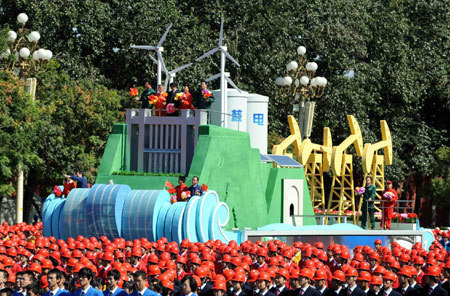Achievements
Solar panels at parade highlight changes in China's energy use
(Xinhua)
Updated: 2009-10-01 14:34
|
|
Solar panels held by a formation of energy workers at the National Day parade on Thursday demonstrated China's determination to shift to renewable energy in handling climate change.
Surrounded by energy workers, a float carrying the sculptures of windmills and oil reserve containers, as well as a banner reading "Striving to develop clean energy," moving past Tian'anmen Square at the magnificent pageant marking New China's 60th anniversary of founding.
As the world's top energy producer and second largest consumer, it takes several decades for China to rely on its own energy supply to power the double-digit growth of the world's third largest economy.
China is the world's top coal maker and the fifth largest crude oil producer.
As the global efforts on cutting greenhouse gas emissions has never been so urgent, China realized that to solely rely on fossil fuel will hardly sustain its rocketing economic growth.
Over the past decades, changes have already taken place.
Of the total energy use, China's coal consumption has been lowered from 96 percent in 1952 to 68 percent last year.
The use of hydro, nuclear and wind power was raised from 1.61 percent to 9.5 percent.
The nation boasts Asia's biggest wind power turbine engine, and some 9,100 megawatts of nuclear energy capacity.
It has approved the construction of additional reactors to increase output to 32,000 megawatts.
To save fuel, China's pioneering automaker BYD began selling the world's first plug-in hybrid vehicle in December last year and plans to make it to the European and North American markets.
Official data showed China cut its energy consumption per unit of GDP by 10.1 percent from 2006 to 2008, which means it saved 300 million tons of standard coal and cut carbon dioxide emissions by 750 million tons.
China reported a drop of 3.35 percent of energy consumption per unit of GDP in the first half of this year from the same period a year ago, laying the foundations for a 20 percent cut by 2010 from the level in 2005.












